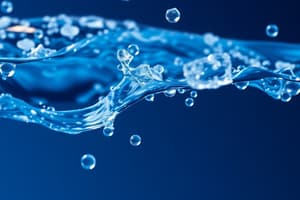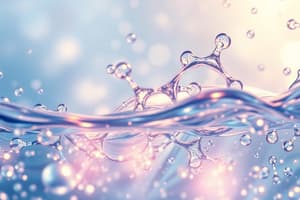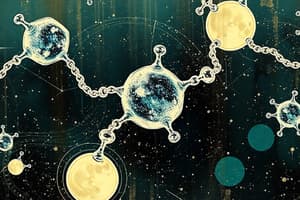Podcast
Questions and Answers
Translational and thermal motion causes liquid water molecules to reorient approximately every 10–12 seconds.
A)hydrogen bond
B)rotational
C)H3PO4
D)H2PO4
E)HPO4
F)disordered
G)positive entropy
H)negative entropy
I)higher electronegativity
J)insoluble
K)tetrahedral arrangement
L)acid
M)base
N) only partially ionized
Translational and thermal motion causes liquid water molecules to reorient approximately every 10–12 seconds. A)hydrogen bond B)rotational C)H3PO4 D)H2PO4 E)HPO4 F)disordered G)positive entropy H)negative entropy I)higher electronegativity J)insoluble K)tetrahedral arrangement L)acid M)base N) only partially ionized
B
The 104.5° bond angle in the water molecule is the result of the of electron orbitals around oxygen.
A)hydrogen bond
B)rotational
C)H3PO4
D)H2PO4
E)HPO4
F)disordered
G)positive entropy
H)negative entropy
I)higher electronegativity
J)insoluble
K)tetrahedral arrangement
L)acid
M)base
N) only partially ionized
The 104.5° bond angle in the water molecule is the result of the of electron orbitals around oxygen. A)hydrogen bond B)rotational C)H3PO4 D)H2PO4 E)HPO4 F)disordered G)positive entropy H)negative entropy I)higher electronegativity J)insoluble K)tetrahedral arrangement L)acid M)base N) only partially ionized
K
The polarity of the O–H bond is caused by the of oxygen relative to that of hydrogen.
A)hydrogen bond
B)rotational
C)H3PO4
D)H2PO4
E)HPO4
F)disordered
G)positive entropy
H)negative entropy
I)higher electronegativity
J)insoluble
K)tetrahedral arrangement
L)acid
M)base
N) only partially ionized
The polarity of the O–H bond is caused by the of oxygen relative to that of hydrogen. A)hydrogen bond B)rotational C)H3PO4 D)H2PO4 E)HPO4 F)disordered G)positive entropy H)negative entropy I)higher electronegativity J)insoluble K)tetrahedral arrangement L)acid M)base N) only partially ionized
I
For the represented by D–H....A, the donor D is weakly acidic and the acceptor A is weakly basic.
A)hydrogen bond
B)rotational
C)H3PO4
D)H2PO4
E)HPO4
F)disordered
G)positive entropy
H)negative entropy
I)higher electronegativity
J)insoluble
K)tetrahedral arrangement
L)acid
M)base
N) only partially ionized
For the represented by D–H....A, the donor D is weakly acidic and the acceptor A is weakly basic. A)hydrogen bond B)rotational C)H3PO4 D)H2PO4 E)HPO4 F)disordered G)positive entropy H)negative entropy I)higher electronegativity J)insoluble K)tetrahedral arrangement L)acid M)base N) only partially ionized
Octane molecules dispersed in water tend to aggregate because that allows water molecules to be more .
A)hydrogen bond
B)rotational
C)H3PO4
D)H2PO4
E)HPO4
F)disordered
G)positive entropy
H)negative entropy
I)higher electronegativity
J)insoluble
K)tetrahedral arrangement
L)acid
M)base
N) only partially ionized
Octane molecules dispersed in water tend to aggregate because that allows water molecules to be more . A)hydrogen bond B)rotational C)H3PO4 D)H2PO4 E)HPO4 F)disordered G)positive entropy H)negative entropy I)higher electronegativity J)insoluble K)tetrahedral arrangement L)acid M)base N) only partially ionized
The insolubility of nonpolar molecules in water is due to the large , which is the result of water molecules forming an ordered network surrounding nonpolar molecules.
A)hydrogen bond
B)rotational
C)H3PO4
D)H2PO4
E)HPO4
F)disordered
G)positive entropy
H)negative entropy
I)higher electronegativity
J)insoluble
K)tetrahedral arrangement
L)acid
M)base
N) only partially ionized
The insolubility of nonpolar molecules in water is due to the large , which is the result of water molecules forming an ordered network surrounding nonpolar molecules. A)hydrogen bond B)rotational C)H3PO4 D)H2PO4 E)HPO4 F)disordered G)positive entropy H)negative entropy I)higher electronegativity J)insoluble K)tetrahedral arrangement L)acid M)base N) only partially ionized
A strong acid is completely ionized in water, whereas a weak acid is
A)hydrogen bond
B)rotational
C)H3PO4
D)H2PO4
E)HPO4
F)disordered
G)positive entropy
H)negative entropy
I)higher electronegativity
J)insoluble
K)tetrahedral arrangement
L)acid
M)base
N) only partially ionized
A strong acid is completely ionized in water, whereas a weak acid is A)hydrogen bond B)rotational C)H3PO4 D)H2PO4 E)HPO4 F)disordered G)positive entropy H)negative entropy I)higher electronegativity J)insoluble K)tetrahedral arrangement L)acid M)base N) only partially ionized
Phosphate (pK = 2.15, pK = 6.82, and pK3 = 12.38) will be mostly in the HPO42– form at pH
1
7.2. At pH 5.82 it is mostly in the form.
A)hydrogen bond
B)rotational
C)H3PO4
D)H2PO4
E)HPO4
F)disordered
G)positive entropy
H)negative entropy
I)higher electronegativity
J)insoluble
K)tetrahedral arrangement
L)acid
M)base
N) only partially ionized
Phosphate (pK = 2.15, pK = 6.82, and pK3 = 12.38) will be mostly in the HPO42– form at pH 1 7.2. At pH 5.82 it is mostly in the form. A)hydrogen bond B)rotational C)H3PO4 D)H2PO4 E)HPO4 F)disordered G)positive entropy H)negative entropy I)higher electronegativity J)insoluble K)tetrahedral arrangement L)acid M)base N) only partially ionized
A solution containing a weak acid (pK = 7.5) and its conjugate base at pH of 8.5 has a good
capacity to buffer the addition of
A)hydrogen bond
B)rotational
C)H3PO4
D)H2PO4
E)HPO4
F)disordered
G)positive entropy
H)negative entropy
I)higher electronegativity
J)insoluble
K)tetrahedral arrangement
L)acid
M)base
N) only partially ionized
A solution containing a weak acid (pK = 7.5) and its conjugate base at pH of 8.5 has a good capacity to buffer the addition of A)hydrogen bond B)rotational C)H3PO4 D)H2PO4 E)HPO4 F)disordered G)positive entropy H)negative entropy I)higher electronegativity J)insoluble K)tetrahedral arrangement L)acid M)base N) only partially ionized
A phosphate buffer solution at pH = pK = 2.15 would have equal amounts of phosphate in
1
the form and the H PO
2
– form.4
A)hydrogen bond
B)rotational
C)H3PO4
D)H2PO4
E)HPO4
F)disordered
G)positive entropy
H)negative entropy
I)higher electronegativity
J)insoluble
K)tetrahedral arrangement
L)acid
M)base
N) only partially ionized
A phosphate buffer solution at pH = pK = 2.15 would have equal amounts of phosphate in 1 the form and the H PO 2 – form.4 A)hydrogen bond B)rotational C)H3PO4 D)H2PO4 E)HPO4 F)disordered G)positive entropy H)negative entropy I)higher electronegativity J)insoluble K)tetrahedral arrangement L)acid M)base N) only partially ionized
Rank the following interactions in order of increasing strength (start with the weakest interaction).
Rank the following interactions in order of increasing strength (start with the weakest interaction).
The strongest noncovalent interactions are
The strongest noncovalent interactions are
Hydrogen bonds within liquid water
Hydrogen bonds within liquid water
Urea is a water-soluble product of nitrogen metabolism. How many hydrogen bonds can one urea molecule donate to surrounding water molecules?
Urea is a water-soluble product of nitrogen metabolism. How many hydrogen bonds can one urea molecule donate to surrounding water molecules?
Methanol can act both as a H-bond donor and as a H-bond acceptor. What is the maximal number of H-bonds a single molecule of methanol can form with surrounding water molecules.
Methanol can act both as a H-bond donor and as a H-bond acceptor. What is the maximal number of H-bonds a single molecule of methanol can form with surrounding water molecules.
In a hydrogen bond between a water molecule and another biomolecule
In a hydrogen bond between a water molecule and another biomolecule
Which of the following statements about water is not true?
Which of the following statements about water is not true?
Which of the following statements about water is not true?
Which of the following statements about water is not true?
Which of the following statements about water is incorrect?
Which of the following statements about water is incorrect?
Which of the following statements about water is incorrect?
Which of the following statements about water is incorrect?
Ice
Ice
Covalent C─C and C─H bonds have bond strengths that are approximately times higher than those of H-bonds.
Covalent C─C and C─H bonds have bond strengths that are approximately times higher than those of H-bonds.
The boiling point of water is 264°C higher than the boiling point of methane because
The boiling point of water is 264°C higher than the boiling point of methane because
is exceptionally soluble in water due to the formation of hydrogen bonds.
is exceptionally soluble in water due to the formation of hydrogen bonds.
Molecules such as methanol and ethanol are very soluble in water because
Molecules such as methanol and ethanol are very soluble in water because
Hydrophobic interactions between nonpolar molecules
Hydrophobic interactions between nonpolar molecules
Fatty acids such as palmitate and oleate are usually characterized as
Fatty acids such as palmitate and oleate are usually characterized as
Amphiphilic molecules
Amphiphilic molecules
Which of the following statements about hydrophobic interactions is not true?
Which of the following statements about hydrophobic interactions is not true?
Which of the following is the best explanation for the hydrophobic effect?
Which of the following is the best explanation for the hydrophobic effect?
In the energetics of transferring hydrocarbons from water to nonpolar solvents, the factor TS is commonly
In the energetics of transferring hydrocarbons from water to nonpolar solvents, the factor TS is commonly
Globules of up to several thousand amphiphilic molecules arranged with the hydrophilic groups on the surface and the hydrophobic groups buried in the center that form in water are called
Globules of up to several thousand amphiphilic molecules arranged with the hydrophilic groups on the surface and the hydrophobic groups buried in the center that form in water are called
Sheets composed of two layers of amphipathic molecules arranged with the hydrophilic groups on the surface and the hydrophobic groups buried in the center that form in water are called
Sheets composed of two layers of amphipathic molecules arranged with the hydrophilic groups on the surface and the hydrophobic groups buried in the center that form in water are called
Physical properties that depend on the amounts of various species, rather than the identities of those species, are called
Physical properties that depend on the amounts of various species, rather than the identities of those species, are called
Osmotic pressure is a function of
Osmotic pressure is a function of
K , the ionization constant of water, is. at
K , the ionization constant of water, is. at
Weak acids
Weak acids
A solution is made by mixing 0.05 mL of 1.0 M HCl with 999.95 mL of pure water. Calculate the pH of the resulting solution (assume the total volume is 1.0 L).
A solution is made by mixing 0.05 mL of 1.0 M HCl with 999.95 mL of pure water. Calculate the pH of the resulting solution (assume the total volume is 1.0 L).
The pH of coffee is 5.6. The pH of grapefruit juice is 2.6. This means that the proton concentration in coffee is
The pH of coffee is 5.6. The pH of grapefruit juice is 2.6. This means that the proton concentration in coffee is
A solution is made by mixing 1.0 mL of 1.0 M acetic acid (pK = 4.76, K = 1.74 x 10–5 )
a
with one 999 mL of pure water. Calculate the pH of the resulting solution (assume the total volume is 1.0 L).
A solution is made by mixing 1.0 mL of 1.0 M acetic acid (pK = 4.76, K = 1.74 x 10–5 ) a with one 999 mL of pure water. Calculate the pH of the resulting solution (assume the total volume is 1.0 L).
You mix 999 mL pure water and 1 mL of 2.0 M NaOH. Calculate the pH of the resulting solution. (assume the total volume is 1.0 L).
You mix 999 mL pure water and 1 mL of 2.0 M NaOH. Calculate the pH of the resulting solution. (assume the total volume is 1.0 L).
The pH of a 0.1 M solution of sodium acetate would be
The pH of a 0.1 M solution of sodium acetate would be
Phosphoric acid is a polyprotic acid, with pK values of 2.14, 6.86, and 12.38. Which ionic form predominates at pH 9.3?
Phosphoric acid is a polyprotic acid, with pK values of 2.14, 6.86, and 12.38. Which ionic form predominates at pH 9.3?
To make a phosphate buffer at pH 6.82 starting with one liter of 10 mM phosphoric acid (pKs are 2.15, 6.82, and 12.38), you could add
To make a phosphate buffer at pH 6.82 starting with one liter of 10 mM phosphoric acid (pKs are 2.15, 6.82, and 12.38), you could add
You mix equal volumes of 0.05 M NaH PO and 0.05 M Na HPO (pK's for phosphoric acid
24
are 2.15, 6.82 and 12.38). Which of the following best describes the resulting solution?
You mix equal volumes of 0.05 M NaH PO and 0.05 M Na HPO (pK's for phosphoric acid 24 are 2.15, 6.82 and 12.38). Which of the following best describes the resulting solution?
To make an acetate buffer at pH 4.76 starting with 500 mL of 0.1 M sodium acetate (pK acetic acid = 4.76), you could add
To make an acetate buffer at pH 4.76 starting with 500 mL of 0.1 M sodium acetate (pK acetic acid = 4.76), you could add
The pK of citric acid is 3.09. What is the citric acid : monosodium citrate ratio in a 1.0 M
1
citric acid solution with a pH of 2.09?
The pK of citric acid is 3.09. What is the citric acid : monosodium citrate ratio in a 1.0 M 1 citric acid solution with a pH of 2.09?
The pKs of succinic acid are 4.21 and 5.64. How many grams of monosodium succinate (FW = 140 g/mol) and disodium succinate (FW = 162 g/mol) must be added to 1 L of water to produce a solution with a pH 5.28 and a total solute concentration of 100 mM? (Assume the total volume remains 1 liter, answer in grams monosodium succinate, grams disodium succinate, respectively.)
The pKs of succinic acid are 4.21 and 5.64. How many grams of monosodium succinate (FW = 140 g/mol) and disodium succinate (FW = 162 g/mol) must be added to 1 L of water to produce a solution with a pH 5.28 and a total solute concentration of 100 mM? (Assume the total volume remains 1 liter, answer in grams monosodium succinate, grams disodium succinate, respectively.)
What is the approximate pK of a weak acid HA if a solution 0.1 M HA and 0.3 M A– has a
a
pH of 6.5?
What is the approximate pK of a weak acid HA if a solution 0.1 M HA and 0.3 M A– has a a pH of 6.5?
A graduate student at SDSU wants to measure the activity of a particular enzyme at pH 4.0. To buffer her reaction, she will use a buffer system based on one of the acids listed below, which acid is most appropriate for the experiment?
A graduate student at SDSU wants to measure the activity of a particular enzyme at pH 4.0. To buffer her reaction, she will use a buffer system based on one of the acids listed below, which acid is most appropriate for the experiment?
The pH at the midpoint in the titration of an acid with a base is
The pH at the midpoint in the titration of an acid with a base is
The capacity of a buffer to resist changes in pH upon addition of protons or hydroxide ions depends on
The capacity of a buffer to resist changes in pH upon addition of protons or hydroxide ions depends on
The pH of blood is affected by
The pH of blood is affected by
Flashcards are hidden until you start studying



